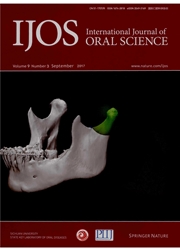

 中文摘要:
中文摘要:
FAM20A has been studied to a very limited extent. Mutations in human FAM20 A cause amelogenesis imperfecta, gingival fibromatosis and kidney problems. It would be desirable to systemically analyse the expression of FAM20 A in dental tissues and to assess the pathological changes when this molecule is specifically nullified in individual tissues. Recently, we generated mice with a Fam20A-floxed allele containing the beta-galactosidase reporter gene. We analysed FAM20 A expression in dental tissues using X-Gal staining, immunohistochemistry and in situ hybridization, which showed that the ameloblasts in the mouse mandibular first molar began to express FAM20 A at 1 day after birth, and the reduced enamel epithelium in erupting molars expressed a significant level of FAM20 A. By breeding K14-Cre mice with Fam20Aflox/floxmice, we created K14-Cre;Fam20Aflox/flox(conditional knock out, c KO) mice, in which Fam20 A was inactivated in the epithelium. We analysed the dental tissues of c KO mice using X-ray radiography, histology and immunohistochemistry. The molar enamel matrix in c KO mice was much thinner than normal and was often separated from the dentinoenamel junction. The Fam20A-deficient ameloblasts were non-polarized and disorganized and were detached from the enamel matrix. The enamel abnormality in c KO mice was consistent with the diagnosis of amelogenesis imperfecta. The levels of enamelin and matrix metalloproteinase 20 were lower in the ameloblasts and enamel of c KO mice than the normal mice. The c KO mice had remarkable delays in the eruption of molars and hyperplasia of the gingival epithelium. The findings emphasize the essential roles of FAM20 A in the development of dental and oral tissues.
 英文摘要:
英文摘要:
FAM20A has been studied to a very limited extent. Mutations in human FAM20A cause amelogenesis imperfecta, gingival fibromatosis and kidney problems. It would be desirable to systemically analyse the expression of FAM20A in dental tissues and to assess the pathological changes when this molecule is specifically nullified in individual tissues. Recently, we generated mice with a Fam2OA-floxed allele containing the beta-galactosidase reporter gene. We analysed FAM20A expression in dental tissues using X-Gal staining, immunohistochemistry and in situ hybridization, which showed that the ameloblasts in the mouse mandibular first molar began to express FAM20A at 1 day after birth, and the reduced enamel epithelium in erupting molars expressed a significant level of FAM2OA. By breeding K14-Cre mice with Fam20An~x/fl~x mice, we created K14-Cre;Fam20Af/flox/flox (conditional knock out, cKO) mice, in which Fam20A was inactivated in the epithelium. We analysed the dental tissues of cKO mice using X-ray radiography: histology and immunohistochemistry. The molar enamel matrix in cKO mice was much thinner than normal and was often separated from the dentinoenamel junction. The Fam2OA-deficient ameloblasts were non-polarized and disorganized and were detached from the enamel matrix. The enamel abnormality in cKO mice was consistent with the diagnosis of amelogenesis imperfecta. The levels of enamelin and matrix metalloproteinase 20 were lower in the ameloblasts and enamel of cKO mice than the normal mice, The cKO mice had remarkable delays in the eruption of molars and hyperplasia of the gingival epithelium. The findings emphasize the essential roles of FAM20A in the development of dental and oral tissues.
 同期刊论文项目
同期刊论文项目
 同项目期刊论文
同项目期刊论文
 Differential expression and localization of dentin matrix protein 1 ( DMP1 ) fragments in mouse subm
Differential expression and localization of dentin matrix protein 1 ( DMP1 ) fragments in mouse subm 期刊信息
期刊信息
